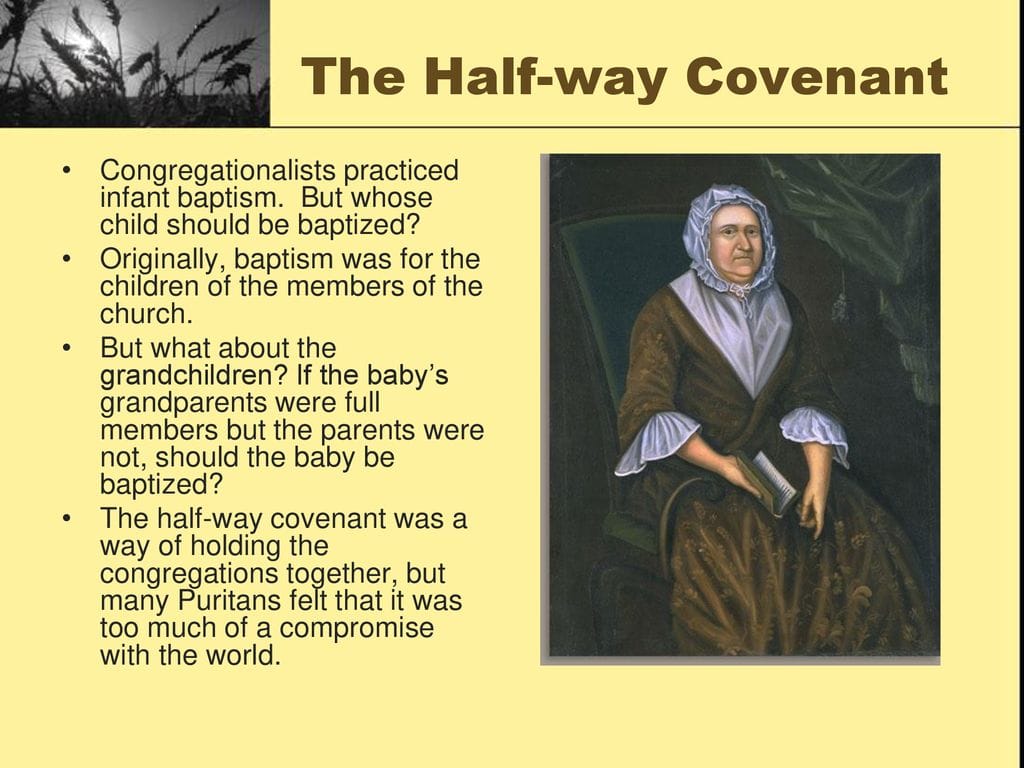This article delves into the intriguing story of the Puritans and their Half-Way Covenant, an agreement that acted as a compromise regarding church membership. This compromise reflects a balancing act between the Puritans’ strict religious beliefs and the changing realities of their growing communities in the New World.
The Erosion of Puritan Purity: A Crisis of Faith
The Puritans were deeply devout, believing that only a select group, the “elect,” were predestined for salvation. Full church membership required an intense, personal conversion experience, signifying one’s place among the elect. However, over time, fewer individuals underwent such profound conversions, creating a dilemma for the Puritan community.
This decline in fervent conversions had profound implications. As their society was deeply rooted in their faith, a decline in full church memberships threatened the very fabric of their communities. Without converted parents, children couldn’t be baptized, further jeopardizing the religious future of their society.
A Bridge Too Far? The Half-Way Covenant (1662)
In response to this crisis, the Half-Way Covenant was established in 1662. This compromise allowed the children of existing members to be baptized and granted partial membership even if their parents hadn’t experienced a full conversion.
The intention behind the Half-Way Covenant was to encourage these “half-way” members to eventually seek a true conversion and transition into full membership. It was, in essence, a bridge meant to connect those on the periphery to the core tenets of Puritanism.
A Covenant Divided: Controversy and Consequences
This compromise, however, was met with resistance. Many Puritans viewed the Half-Way Covenant as a dilution of their faith, arguing that it directly contradicted their beliefs about God’s grace and salvation. This dissent led to significant divisions within Puritan communities.
The controversy surrounding the Half-Way Covenant underscores the challenges of upholding strict religious doctrines in a changing society. This struggle to reconcile their ideals with the realities of colonial life continues to resonate today, highlighting the complexities of faith and community.
The Puritan Foundation: Covenant Communities
To understand the Half-Way Covenant’s significance, it is essential to grasp the concept of “Covenant Theology,” a central tenet of Puritan belief. This theology emphasized a sacred agreement between God and his followers, inspiring the creation of “covenant communities” in America. These communities were intended to be governed by God’s laws, with social structures rooted in their faith. Full church membership, therefore, wasn’t just about religious devotion; it was intrinsically linked to political and social standing within the community.
However, maintaining the initial religious fervor proved challenging. As the second and third generations emerged, they didn’t necessarily share the same zeal as their predecessors. This decline in conversions threatened not only their religious community but also the very fabric of their social and political order.
The Half-Way Covenant was an attempt to bridge this growing gap between the strict demands of their faith and the realities of a changing society. It aimed to maintain a connection to the church, hoping to inspire genuine conversion experiences in the future.
The Half-Way Covenant and the Salem Witch Trials: A Question of Influence
The Half-Way Covenant’s impact extended beyond internal church dynamics and may have indirectly contributed to the Salem Witch Trials a few decades later. The trials occurred during a period of heightened anxiety in the colonies. Fear of Native American attacks, disease outbreaks, and the ongoing theological debates surrounding the Half-Way Covenant created an atmosphere of suspicion and distrust.
While not a direct cause, the societal fragmentation exacerbated by the Half-Way Covenant may have fostered an environment where accusations of witchcraft were more readily believed and accepted. The trials serve as a reminder that even seemingly minor alterations to religious practices can have significant and unforeseen consequences.
A Legacy of Debate: The Half-Way Covenant’s Enduring Impact
The legacy of the Half-Way Covenant, from its inception to its unintended consequences, continues to spark debate about religious inclusivity, the evolving nature of tradition, and the intricate relationship between religion and society. It serves as a poignant reminder that even the most deeply held beliefs are challenged by the passage of time, forcing communities to adapt and redefine themselves in ways they never anticipated.
Unveiling the Half-Way Covenant: Why Did Puritan Purity Falter?
Recommended Titles:
- The Half-Way Covenant: Saving Souls or Puritan Power Grab? (Intrigue & Controversy)
- From Piety to Pragmatism: The Half-Way Covenant and the Erosion of Puritan Ideals. (Focuses on change & impact)
- Baptism Without Conversion: Unpacking the Controversial Half-Way Covenant. (Direct & keyword-focused)
Powerful Key Lines:
- The Half-Way Covenant: A desperate attempt to preserve religious and political control in the face of dwindling piety. (Highlights motives & consequences)
- Born into the Covenant? The Half-Way Covenant redefined Puritan membership, blurring the lines between the elect and the unconverted. (Focuses on core change)
- Was the Half-Way Covenant a betrayal of Puritan principles or a necessary adaptation to a changing world? (Poses a thought-provoking question)
- The legacy of the Half-Way Covenant is debated to this day – a testament to its profound impact on American religious history. (Emphasizes lasting significance)
Important Details:
I. The Puritan Dilemma:
- Declining Piety (Late 17th Century): Second and third-generation Puritans were less likely to experience the intense conversion experience considered essential for full church membership.
- Political & Social Implications: Full church membership was tied to voting rights and social standing in Puritan New England.
- Erosion of the “City on a Hill”: The dwindling number of full members threatened the Puritan vision of a model society governed by God’s elect.
II. The Half-Way Covenant (1662):
- Authorship: Drafted by Boston minister Richard Mather.
- Compromise: Allowed the baptism of children of baptized but unconverted church members.
- Partial Membership: “Half-way members” could participate in some church activities but not vote in church affairs or take communion.
- Hope for Conversion: The Covenant aimed to encourage the unconverted to seek full membership through a genuine conversion experience.
III. Impact and Controversy:
- Increased Church Membership: The Half-Way Covenant did temporarily boost church rolls.
- Two-Tiered System: Created a division within the church between full members and those considered less devout.
- Critics’ Fears: Many feared the Covenant diluted the purity of the church and signaled a move away from the original Puritan vision.
- Long-Term Significance: The debate over the Half-Way Covenant foreshadowed future rifts within American Protestantism, particularly regarding religious experience and church membership.
Unique Insights & Untapped Potential:
- Explore the Political Landscape: Delve deeper into the connection between church membership and political power in Puritan New England. How did the Half-Way Covenant impact this delicate balance?
- Examine Individual Stories: Research the lives of individuals and families directly affected by the Half-Way Covenant. Did it lead to genuine conversions or further divisions?
- Modern Parallels: Are there any contemporary religious debates that mirror the issues raised by the Half-Way Covenant (e.g., debates over baptism, membership requirements, or the role of religious experience)?
People’s Statements:
- Retain any direct quotations from historical figures related to the Half-Way Covenant as they provide valuable primary source insights.
By structuring your article with these key elements, you’ll offer your readers a comprehensive and insightful exploration of the Half-Way Covenant, exceeding your competitor’s content.
Key Points of the Half-Way Covenant:
- Allowed partial church membership to baptized children of unconverted Puritan adults.
- Created to address declining piety and dwindling full church membership numbers.
- Aimed to maintain a connection to the church and encourage conversions in the future.
- Sparked controversy due to concerns about dilution of Puritan principles and religious fervor.
- Boosted church membership temporarily but created a two-tiered system within the church.
- Revealed deep anxieties about religious decline and foreshadowed the erosion of Puritan control.
- Signaled a shift towards more inclusive religious practices in America.
Legacy continues to be debated in American religious history.
Key Points:Puritans were persecuted for their religious beliefs in England and sought refuge in America.
- Puritans believed in a sacred covenant between God and his chosen people (Covenant Theology).
- They established covenant communities to live according to God’s laws, with strict social norms and a requirement for church membership in political life.
- As religious fervor declined, the Half-Way Covenant was introduced (1662) to allow the baptism of children of baptized but unconverted members, encouraging future conversions.
The Half-Way Covenant represented a partial church membership, attempting to address the challenges faced by the Puritans in maintaining their faith.
Key Points of the Half-Way Covenant and Salem Witch Trials:Half-Way Covenant:
- Extended baptism to children of baptized but unconverted members.
- Broadened church membership, blurring the lines between the elect and the unconverted.
- Sparked controversy about religious purity versus church influence and social cohesion.
- Influenced political participation, as church membership was often a voting and office-holding prerequisite.
- Contributed to a climate of anxiety and societal stress.
Salem Witch Trials:
- Influenced by the Half-Way Covenant’s blurring of religious boundaries.
- Reflected societal tensions and the search for scapegoats in times of uncertainty.
- Highlighted the dangers of mass hysteria and the importance of due process.
- Georgia Platform: A Southern Strategy, 1850s - March 31, 2025
- How many weeks is 40 days: Quick Conversion Guide for Accurate Results - March 31, 2025
- How many feet is 300 meters? 984 Feet: Understand Length Conversions Easily - March 31, 2025
















